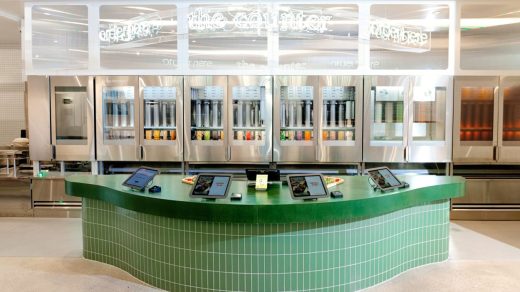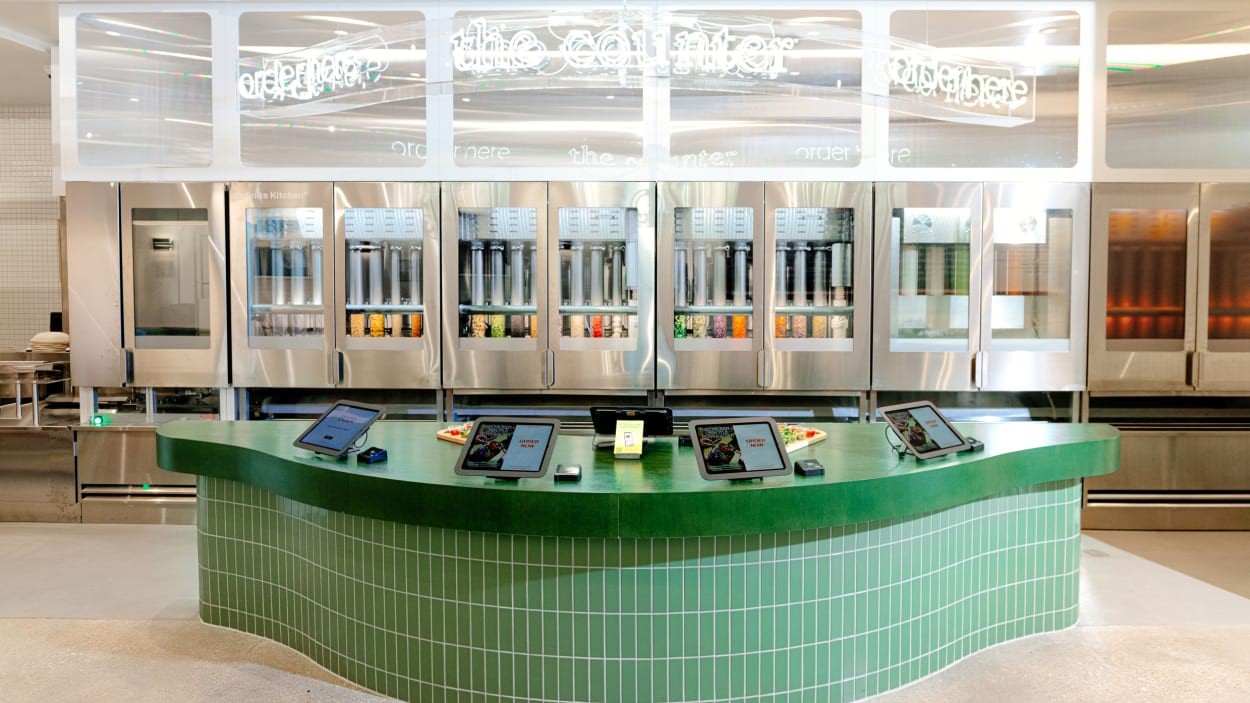What the heck is going on with Sweetgreen?
In May, Sweetgreen opened a long-awaited location in Naperville, Illinois, about 30 miles outside of Chicago. Like many of Sweetgreen’s 220 locations, it’s bright, with neon signage and smiling employees. Unlike any of them, however, it’s staffed by a salad-making robot, which Sweetgreen calls its Infinite Kitchen.
The robot dispenses salad ingredients by shooting perfect portions from tubes into bowls. The company spent years developing the tech. It took two years, for example, to figure out how to automate the crumbling of goat cheese atop a salad.
With Sweetgreen’s third-quarter earnings report out this week, which shows that the company continues to lose money but not as much as it did a year ago, both CEO Jonathan Neman and analysts see this one store in the south suburbs of Chicago as the future of the chain.
When Neman talks about the future of the salad chain, he’s bullish on automation as a way to “improve throughput” at the restaurants. That is: a way for Sweetgreen’s staff and its machines to pump out as many salads as possible. Company executives say that the robot can produce up to 500 salads per hour. In its first month of operation, the Naperville store performed better than a typical outlet. Its 26% sales margin was “significantly” higher than any other Sweetgreen location in its first month, which excites Wall Street.
But rethinking the salad business is proving to be a slow, if promising, endeavor.
“A lot of other companies are trying to figure out how to add automation to their experience and are not willing to start over,” Neman told a Wall Street Journal reporter recently. “I’m willing to blow the whole thing up.”
COVID-19 hit Sweetgreen particularly hard
Most of its stores were located in urban locations, patronized by nearby office workers looking for lunchtime salads. In 2020, same-store sales at the restaurants were down 26%. While its fortunes have improved slightly, Sweetgreen has operated at a significant loss since its initial public offering almost exactly two years ago. IPO shares were priced at $28. They closed Friday under $10. That’s a more than 80% decline.
“Off the back of COVID, we had to spend more time stabilizing our company than building it,” Neman said this week.
But he had another message to assure investors: “We are back on the offensive,” he said, promising that the chain’s investment on delivering fresh food fast will eventually pay off.
Analysts on the call wanted to talk more about the robots. Specifically, they wondered, when will more of them show up?
Every fast-food CEO dreams of automation
Initially, Neman predicted that all new Sweetgreen locations would be automated in five years. Now he says that next year the company will open between seven and nine locations with robots, and it will retrofit two to four existing locations. In total, the chain aims to open 28 new locations in 2024.
“The reason for the slight slowdown is to better integrate the Infinite Kitchen technology into the pipeline,” Neman said, seemingly hedging the slower-than-expected rollout.
Sweetgreen’s Infinite Kitchen arrived thanks to the chain’s $50 million purchase of Spyce in August 2021, a Boston-based robotic restaurant startup that counted chefs Thomas Keller and Daniel Boulud among its early backers. But the salad chain has been thinking about robotics for much longer. I remember interviewing the chain’s then-head of automation during a panel at a 2019 restaurant technology conference; I also remember this person giving exactly zero details about the chain’s plans to deploy any kind of salad bot.
Four years later, we have more details but few operational robots.
The tech-powered restaurant company thesis remains unproven
Sweetgreen is among a handful of modern restaurant chains that have preferred to talk about their business in tech terms, explaining how they operate and scale like a tech company that serves food, rather than a restaurant company that uses technology. It’s helped them explain away the financial losses. Like a tech company that’s historically chased scale above profit, Sweetgreen will apply its big and expensive ideas to optimize salad production.
“Their profit problem is, and has been, that their above-restaurant spend is scaled to the restaurant brand they wish to become, rather than to the restaurant brand they are,” Meredith Sandland, CEO of restaurant software company Empower Delivery and a former Taco Bell executive, told me. “Some investors are willing to tolerate these losses in pursuit of the future. For some investors, that is not a good fit.”
Despite its efforts to move fast, Sweetgreen has learned that salad doesn’t scale like software. As much as it might want to be a tech company with room to experiment and iterate, it needs to make decisions like a restaurant.
Sweetgreen steps up to the plate
Earlier this month, Sweetgreen introduced three new menu items, one salmon dish and two different types of chicken with sides, dubbed protein plates. They’re meant to attract more evening business; only about a third of Sweetgreen’s current customers visit for dinner. “We’re building out the plate category to appeal to more customers, particularly at dinnertime,” Neman said.
The plates come with a new tagline: “You don’t have to be a salad person to be a Sweetgreen person.”
Sweetgreen is, of course, synonymous with fancy salads, and it’s hoping to optimize their production without losing its high-end reputation. Over the past three months, Neman said Sweetgreen moved preparation of its five most popular dressings out of the restaurants to make them more consistent. Neman characterized the move as a yearslong decision “that was done with much thought and care.”
“This move has allowed our team members to shift their focus away from prepping some of our most intensive recipes and instead focus on hospitality and throughput,” he added, invoking restaurant executives’ favorite angle on new tech: It frees up human employees to provide better service. (Of course, serving more customers and completing more orders in the same time frame runs counter to being freed up to provide better service, and throughput came up six times on the earnings call versus four references to hospitality.)
The Chipotle effect
All of this talk of optimization and throughput and robots has become par for the course from restaurant chains on the rise. Fast-casual pioneer Chipotle has also turned to automation to help beef up its bottom line.
But Chipotle, with thousands of stores to Sweetgreen’s 220, has the luxury of building in private. It runs a test kitchen near its Orange County, California, headquarters where it rigorously tests new menu items and emerging technology. The process can take years. Just ask Chippy, a tortilla-chip-making bot that landed in just one Chipotle location last year. Chipotle tweaked the bot to churn out slightly imperfect tortilla chips, better simulating the human experience. If it performs well at its test location, the robot might show up in more of them.
Chipotle is also testing a robot from Hyphen, a company it invested in last year. The bot works under the counter to pump out burrito bowls while human employees fold burritos and make kids meals above. Curt Garner, Chipotle’s chief customer and technology officer, says that unlike Sweetgreen’s robot, which is the centerpiece of its stores, robots in Chipotle locations will work in the kitchen, away from customers.
Another factor very much in Chipotle’s favor? Its stock is up more than 300% in the past five years.
Later this year, Sweetgreen will finally open its second Infinite Kitchen concept, giving more customers their own taste of robot salad. In total, Sweetgreen will open 38 new stores this year, nearly half in new markets like Tampa, Florida, and Milwaukee.
But the robot will staff a store in a location primed for the spectacle: Huntington Beach, California—a short drive from Chipotle HQ.
(20)



